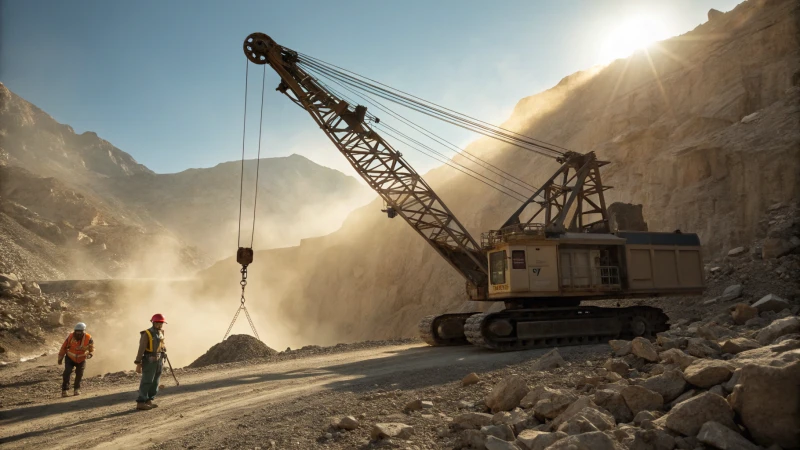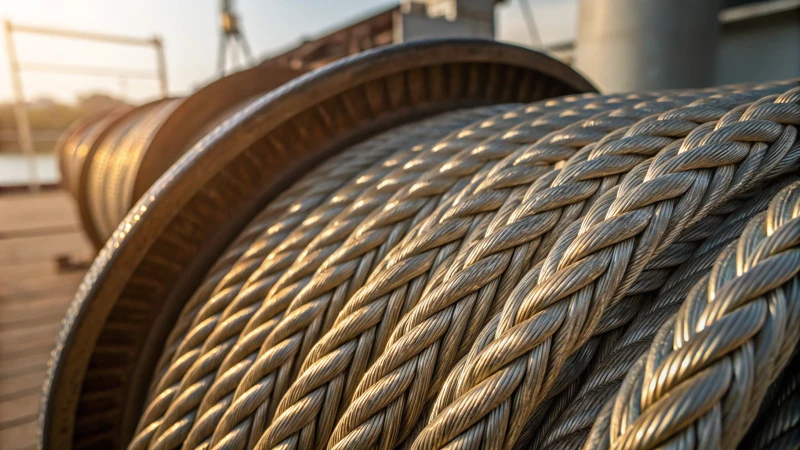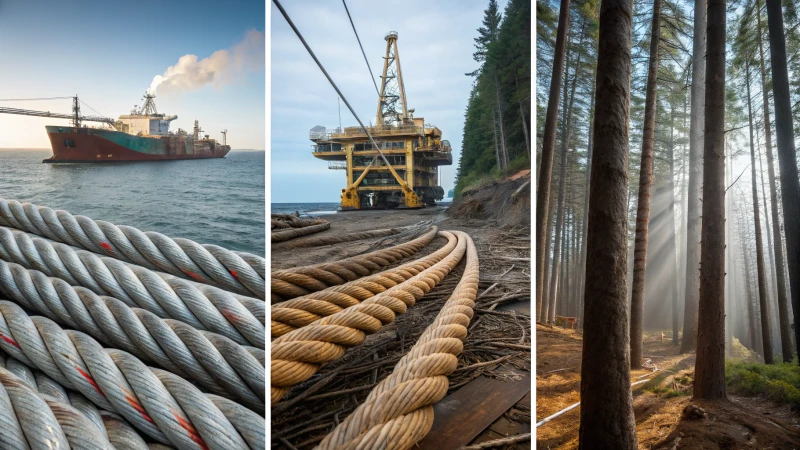
In the tough and gritty world of mining, both equipment and operators face immense challenges. Steel wire ropes quietly become the backbone of mining cranes, ensuring safety and reliability.
Steel wire ropes are vital for mining cranes because they offer high tensile strength, durability, and resistance to harsh conditions. These ropes manage heavy loads with precision, making them indispensable in mining operations.
While we know steel wire ropes are crucial, I once witnessed their importance firsthand. Picture a massive crane hoisting tons of ore—it's the wire ropes holding everything together. Without their incredible strength and durability, operations would come to a standstill. Their ability to endure extreme conditions, thanks to innovations like multi-strand braiding technology, ensures they perform under pressure. This isn't just about lifting; it's about keeping entire projects moving forward safely and efficiently. Let's dive into what makes these steel wires the unsung heroes of mining cranes.
Steel wire ropes are crucial for crane safety.True
Steel wire ropes ensure the safe handling of heavy loads in mining.
Steel wire ropes are less durable than synthetic alternatives.False
Steel wire ropes are more durable due to their high tensile strength.
What Makes Steel Wire Ropes Strong and Durable?
I've often marveled at how steel wire ropes hold together entire industries with their incredible strength and resilience. They’re like the unsung heroes of construction and mining, quietly doing their job so efficiently that we rarely give them a second thought.
Steel wire ropes owe their strength and durability to multi-strand braiding, high-tensile materials, and protective coatings. These features ensure the ropes can handle heavy loads and resist harsh environments, making them reliable for demanding tasks.

Multi-Strand Braiding Technology
I remember the first time I learned about multi-strand braiding technology—I was amazed at how such a simple concept could add so much strength. This technique involves intertwining multiple strands of steel wires, increasing the tensile strength and flexibility of the rope. It's like the ropes we used to braid as kids, but on a much more robust scale! In industries like mining operations1, this braiding is crucial for handling the immense weight without snapping under pressure.
Material Composition
Choosing the right material is like finding the perfect balance between strength and weight. High-carbon steel, for instance, is often my go-to because it offers a remarkable strength-to-weight ratio. I once worked on a marine project where stainless steel was essential due to its corrosion resistance—an absolute must when you’re dealing with saltwater environments. Knowing these material properties really helps in selecting the right rope for each unique application.
| Material | Characteristics | Applications |
|---|---|---|
| High-Carbon Steel | High tensile strength | Construction cranes |
| Stainless Steel | Corrosion resistance | Marine equipment |
Protective Coatings
To extend the life of these ropes, protective coatings are a game changer. I recall a project where galvanization made a significant difference in the rope's durability, protecting it from moisture and chemicals. These coatings not only shield the core material but also reduce wear and tear over time, which is especially important in harsh industrial environments. Coating technologies2 play a crucial role in maintaining rope integrity.
Tensile Strength Standards
In my experience with mining projects, adhering to tensile strength standards is non-negotiable. For instance, mining cranes often require ropes with tensile strengths exceeding 1400 N/mm² to ensure they can handle the rigors of lifting heavy loads. Meeting these standards is critical for both safety and operational efficiency.
Innovative Developments in Wire Ropes
I find it fascinating how innovation continues to push the boundaries of wire rope capabilities. Recent advancements in materials science have introduced designs that improve load distribution while reducing weight. Technologies like carbon nanotube reinforcements are being explored, promising even greater strength without added bulk. It’s an exciting time to see how these developments will enhance what wire ropes can do. Advanced materials3 are paving new paths for future applications.
High-carbon steel is used for its corrosion resistance.False
High-carbon steel is used for its strength, not corrosion resistance.
Multi-strand braiding increases tensile strength of wire ropes.True
Intertwining strands enhances tensile strength and flexibility.
How Do Multi-Strand Braiding Techniques Enhance Performance?
Remember the last time you marveled at the strength and flexibility of a seemingly simple rope? There's more to it than meets the eye, thanks to multi-strand braiding techniques.
Multi-strand braiding techniques boost performance by enhancing tensile strength, flexibility, and fatigue resistance, making materials ideal for high-demand applications.

Understanding Multi-Strand Braiding
I remember when I first learned about multi-strand braiding—it was like uncovering a secret art. This process involves weaving multiple strands together to form a robust composite structure. It’s fascinating how this simple yet sophisticated technique transforms materials like steel wire ropes4, especially in industries such as construction and mining. By distributing load evenly across strands, these braided materials become incredibly reliable.
Benefits of Multi-Strand Braiding
-
Increased Tensile Strength: Imagine a mining crane lifting tons of material with ease. This is possible because braided structures offer a higher load-bearing capacity, crucial in mining where tensile strength above 1400 N/mm² is often required.
-
Enhanced Flexibility: Picture a rope that’s not only strong but can bend and twist without breaking. This flexibility is vital in environments like the sea, where adaptability is key.
-
Improved Fatigue Resistance: Think about how a rope weathers stress without showing signs of wear. The braided pattern cleverly reduces stress points, allowing it to endure longer under pressure.
| Attribute | Benefit |
|---|---|
| Tensile Strength | Higher load capacity |
| Flexibility | Adaptability in varied environments |
| Fatigue Resistance | Longer lifespan under stress |
Applications in Different Industries
-
Construction: In this sector, multi-strand braiding is used to produce ropes that meet stringent safety standards, providing both strength and durability for lifting operations. Procurement managers like John5 prioritize these qualities.
-
Mining: Braided ropes offer superior performance in harsh conditions, making them essential for mining operations. Officers like Emma6 look for products that withstand extreme wear.
-
Marine: Resistance to corrosion and flexibility make braided ropes suitable for marine use, where they must endure saltwater and constant movement.
The blend of strength, flexibility, and durability makes multi-strand braiding not just a technique but an invaluable ally across these sectors and more.
Multi-strand braiding increases tensile strength of ropes.True
Braided structures distribute load evenly, enhancing tensile strength.
Braided ropes are unsuitable for marine environments.False
Braided ropes offer flexibility and corrosion resistance, ideal for marine use.
What Are the Safety Standards for Mining Crane Wire Ropes?
Navigating the world of mining operations can be a maze, especially when it comes to safety. The wire ropes used in cranes are more than just equipment; they're lifelines. Let's explore how understanding their safety standards can protect both workers and the bottom line.
Safety standards for mining crane wire ropes require adherence to OSHA and MSHA guidelines. These include regular inspections, proper maintenance, and compliance with specifications for tensile strength and load capacity to prevent accidents and ensure regulatory compliance.

Understanding Regulatory Guidelines
When I first started working with mining crane wire ropes, I realized just how crucial it was to grasp the safety standards that governed their use. Mining crane wire ropes must adhere to stringent regulations set by OSHA7 and MSHA. These guidelines ensure that ropes are reliable and safe, focusing on key aspects like:
- Tensile Strength: With requirements typically above 1400 N/mm², these ropes must be able to handle the heavy loads unique to mining operations.
- Inspection Frequency: Regular inspections are non-negotiable. They help catch wear and tear early before they lead to accidents.
- Load Capacity: Each rope must be perfectly matched to its task to prevent overloads that could jeopardize safety.
Importance of Material and Design
In my journey through various mining projects, I’ve seen how the material composition and design of wire ropes can make or break a project. For example, ropes using multi-strand braiding technology not only boost tensile strength but also enhance fatigue resistance, a crucial factor in demanding environments. Furthermore, galvanized steel ropes8 are a game-changer, offering superior corrosion resistance, which is vital in moisture-heavy conditions typical of mining sites.
| Feature | Benefit |
|---|---|
| Multi-strand Braiding | Increases durability and fatigue resistance |
| Galvanization | Provides corrosion resistance in moisture-heavy areas |
Maintenance and Inspection Protocols
I can’t stress enough the importance of adhering to strict maintenance schedules. This involves regular lubrication and immediate replacement of any ropes showing defects. Utilizing non-destructive testing9 methods is an effective way to identify issues without affecting the rope’s integrity.
- Visual Checks: Always keep an eye out for signs of wear or corrosion.
- Tension Tests: Ensure the rope consistently maintains its tensile properties.
- Replacement Criteria: Follow specific guidelines on when ropes need to be retired.
By fully understanding and implementing these standards, we not only comply with regulations but also optimize operational efficiency and prevent unforeseen equipment failures. Prioritizing these aspects in procurement decisions is essential for ensuring safety and longevity in any mining operation.
Mining crane wire ropes must exceed 1400 N/mm² tensile strength.True
Regulations require mining crane wire ropes to have tensile strength above 1400 N/mm².
Galvanized steel ropes are less corrosion resistant than plain steel.False
Galvanized steel ropes offer enhanced corrosion resistance, unlike plain steel.
How Do Different Environments Affect Wire Rope Selection?
Ever wondered how much thought goes into picking the perfect wire rope?
Different environments affect wire rope selection by influencing corrosion resistance, tensile strength, and fatigue life. For corrosive settings, like marine environments, stainless steel or galvanized ropes are your best bet due to their superior durability.

Understanding Environmental Influences
I remember the first time I had to choose a wire rope for a marine project10. The salty sea air was relentless, and I quickly learned that not all ropes are created equal. In marine environments, where corrosion is a constant threat, opting for stainless steel ropes isn't just a good idea—it's essential. These ropes stand up to the harsh conditions, ensuring safety and longevity.
Corrosion Resistance
Corrosion is like that unwelcome guest who overstays their welcome. In my experience, especially in industrial or marine settings, selecting galvanized or stainless steel ropes is crucial. Their ability to resist rust keeps operations smooth and safe.
| Material Type | Corrosion Resistance | Suitable Environment |
|---|---|---|
| Galvanized Steel | Moderate | Industrial |
| Stainless Steel | High | Marine |
Temperature Variations
There was this one time at a power plant job where the temperature swings were wild. High temperatures can cause havoc on wire ropes if they're not equipped to handle it. This is where heat-resistant coatings or alloys like Inconel come into play, ensuring the ropes don't lose their integrity.
Abrasion and Fatigue Resistance
In mining and construction, I've seen wire ropes take quite a beating from abrasion and cyclic loading. It's like watching a marathon runner—they need endurance! Using multi-strand braiding technology has been a game-changer for enhancing fatigue resistance, allowing these ropes to handle repeated bending and wear.
So, if you're diving into the nitty-gritty of selecting the right wire rope, don't forget to check out the tensile strength requirements11. This ensures that you're not just meeting but exceeding operational demands for safety and performance.
Incorporating these environmental considerations helps procurement managers, like myself, make informed decisions. It’s all about balancing cost with durability and safety, ensuring that we choose the right rope for the job.
Stainless steel wire ropes resist corrosion in marine environments.True
Stainless steel offers high corrosion resistance, ideal for marine use.
Galvanized steel is unsuitable for industrial settings.False
Galvanized steel provides moderate corrosion resistance, suitable for industry.
Conclusion
Steel wire ropes are crucial for mining cranes due to their high tensile strength, durability, and ability to withstand harsh conditions, ensuring safety and efficiency in heavy load operations.
-
Explore how multi-strand braiding enhances rope strength and flexibility, crucial for mining operations. ↩
-
Discover how modern coatings extend rope lifespan by protecting against environmental damage. ↩
-
Learn about cutting-edge materials improving wire rope strength and performance. ↩
-
Explore how multi-strand braiding enhances the performance of steel wire ropes in industrial settings. ↩
-
Learn about the safety standards that construction procurement managers prioritize when selecting lifting equipment. ↩
-
Discover the types of durable ropes preferred in mining operations for their strength and longevity. ↩
-
Discover OSHA's detailed requirements for maintaining safety standards in mining crane operations. ↩
-
Learn how galvanized steel wire ropes offer superior corrosion resistance, essential for mining environments. ↩
-
Explore non-destructive testing methods that ensure wire rope integrity without causing damage. ↩
-
Explore how marine environments affect wire rope corrosion and why stainless steel is preferred. ↩
-
Understand tensile strength requirements to ensure wire ropes meet operational demands. ↩

